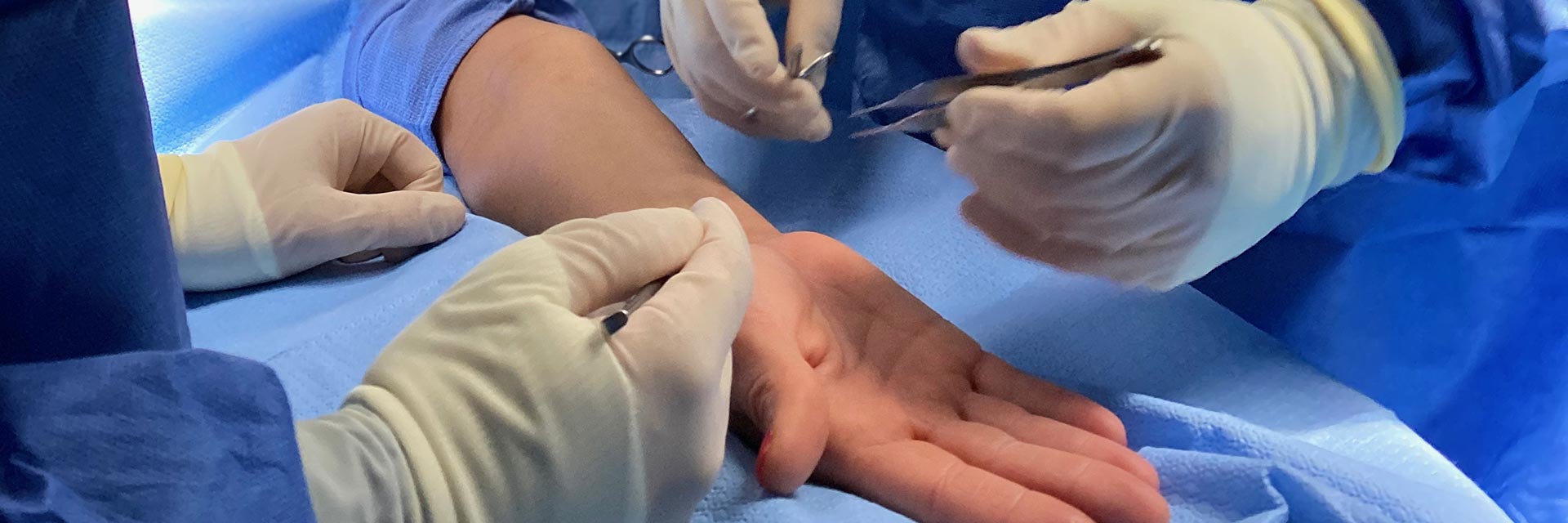Carpal Tunnel Syndrome
I help patients hampered by carpal tunnel syndrome count on their hands again by performing a minimally invasive procedure that alleviates nerve damage with faster recovery time.Tulsa’s Carpal Tunnel Syndrome Specialist
Christopher Treat, D.O. practices general orthopedic surgery with a subspecialty focus on the treatment of carpal tunnel syndrome using a minimally invasive technique called endoscopic carpal tunnel release.
Following his orthopedic surgery residency, Dr. Treat completed two separate fellowships focusing on different aspects of upper extremity care. During his hand and upper extremity fellowship at the University of Pittsburgh Medical Center in Pittsburgh, Pennsylvania, Dr. Treat developed his treatment approach for carpal tunnel syndrome.
Utilizing a thin instrument inserted through a tiny incision, Dr. Treat is able to view and cut the transverse carpal ligament without needing to open up the entire wrist. Compared to the traditional surgical method, this outpatient procedure is much quicker and less invasive with a faster recovery period.
Dr. Treat’s Minimally Invasive Carpal Tunnel Treatment
I treat every patient I see as if they are a member of my family. When you trust me for your carpal tunnel syndrome treatment, you will get a straightforward diagnosis and treatment plan tailored to your lifestyle and individual needs.
If your condition does require surgery, I perform a minimally invasive, out-patient procedure called “endoscopic carpal tunnel release” that provides faster healing of your hand than the traditional, invasive surgery technique.
Are You Ready to Count on Your Hands Again?
Schedule an Appointment
– Accepting New Patients –
What is Carpal Tunnel Syndrome?
Carpal tunnel syndrome, also called median nerve compression, is a common condition in which the nerve that runs through the middle of your wrist becomes compressed or pinched, causing pain and lack of function in your hand.
The carpal tunnel is a passageway running between your wrist and hand on the palm side that is made up of bones, ligaments, and tendons. Because the carpal tunnel is so narrow, the median nerve running through it can become pinched or compressed.
While age, activities, and underlying health conditions can contribute to carpal tunnel syndrome, it is a common condition that can affect athletes, office workers, or manual laborers alike.
Symptoms of Carpal Tunnel Syndrome
Carpal tunnel syndrome symptoms you may experience are often similar to those of other health conditions and can include:
- Burning or tingling in your fingers
- Pain or numbness in one or both of your hands
- Pain or numbness that gets worse at night
- “Pins and needles” feeling in your fingers
- Swollen feeling in your fingers
- Weakness when gripping objects
Causes of Carpal Tunnel Syndrome
Carpal tunnel syndrome can have multiple causes and includes factors related to health conditions or physical activity such as:
- Changes in your blood sugar levels (for diabetics)
- Family history of carpal tunnel syndrome
- Frequent, repetitive, grasping movements
- Frequent, repetitive, small hand movements (like typing or using a keyboard)
- Hormonal or metabolic changes (menopause, pregnancy, or thyroid imbalance)
- Joint or bone diseases (like various forms of arthritis)
- Other hand conditions or wrist injuries
Diagnosing Carpal Tunnel Syndrome
During your first office visit, we will go over your health history and symptoms and I will perform a physical evaluation of your hand and wrist. If needed, your situation may require one of the following diagnostic tests.
Nerve Conduction
- In a nerve conduction study, an electrical impulse is passed through the median nerve. If the nerve impulse is slower through the carpal tunnel, you may have carpal tunnel syndrome.
X-Ray
- An x-ray of the affected wrist is not helpful in diagnosing carpal tunnel syndrome but it will rule out or catch other causes of pain and discomfort, including arthritis and fractures.
Surgical and Non-Surgical Treatments for Carpal Tunnel Syndrome
You have non-surgical treatment options available to help relieve the pain and symptoms of carpal tunnel syndrome. If you do not have success with these, there are two outpatient surgical treatments designed to alleviate pressure on your median nerve by cutting the transverse carpal ligament and allowing scar tissue to fill the gap as it heals.
Surgical Treatments for Carpal Tunnel Syndrome
- Endoscopic Carpal Tunnel Release – In this minimally-invasive procedure, a single one-half-inch incision is made in your wrist where a small tube containing an endoscopic camera and a tiny cutting tool are inserted. The camera guides the tube while the cutting tool is used to cut the transverse carpal ligament, resulting in less damage to your hand a faster recovery time.
- Open Carpal Tunnel Release – This is the more invasive surgical option in which a surgeon makes a two-inch incision near your wrist, cutting through the hand to separate the transverse carpal ligament.
Non-Surgical Treatments for Carpal Tunnel Syndrome
- Taking anti-inflammatory medications
- Stretching and strengthening your wrist through exercises (often with a physical therapist)
- Wearing a splint to limit wrist movement
- Making ergonomic changes to your worksite
- Receiving steroid injections in the carpal tunnel to reduce inflammation
Ready for Carpal Tunnel Syndrome Relief?
Dr. Treat will Treat You Like Family
Schedule an Appointment
– Accepting New Patients –




